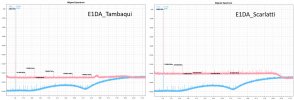OK, let's give this a try. I suspect there will be cases where not ignoring silence at the start will result in a larger mismatch, but then, it's an option and can be turned on and off as desired
 https://app.box.com/s/hlglgy3aj39rjfxu343fho4t0cdrq9v8
https://app.box.com/s/hlglgy3aj39rjfxu343fho4t0cdrq9v8
The setting looks like this (and is turned ON, by default to be compatible with how it worked before):
View attachment 274758
The result with my recording chain looks like this (raw recordings, no alignment done). With this setting ON, as it was previously:
View attachment 274759
And with the setting turned OFF (silence is not ignored at the start):
View attachment 274762
Let me know how it works out, I'll make this an official release 2.0.9 if it works for you.
Thank you SO much!

Worked flawlessly when using ASIO with
RCA->RCA -connection. I matched over 6 minute track two times, both runs were perfectly aligned with the reference and all 3 tracks were exactly the same length, by a single sample. I call it perfection!
However I still have a problem. I usually use the
optical output of my sound card to feed my
DAC (to prevent the ground loops when measuring amps) and it uses ASIO channel
3 and 4 for the optical output (
RCAs are 1 and 2). DW doesn't support more than 2 ASIO channels, so I'll have to use the
VB-Audio ASIO Bridge to convert ASIO channel 3 and 4 to
WASAPI channels 1 and 2 to be able to use my setup with DW:
This adds a significant delay (About 1.5 seconds) to my chain (Reference, ASIO and my converted WASAPI below):
This seems to be too much for DW to align the tracks. Cutting a half second off from the start of the WASAPI recording with Audacity seems to help.
@pkane do you have any plans to add support for multichannel devices to DeltaWave just like you did with MultiTone?
It can be a little bit trickier however because DW uses the predetermined channels (L, R, stereo, L+L, R+R, R+L, L+R)...
A native multichannel support would make DeltaWave perfect!



